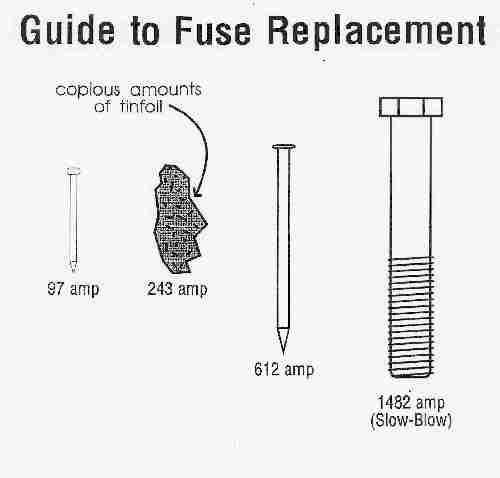|
|
 
|
|
Author
|
Topic: Amp rack electrical supply
|
|
|
|
|
|
|
|
|
Tom Sauter
Expert Film Handler

Posts: 163
From: Buffalo, NY, USA
Registered: Sep 2000
|
 posted 07-31-2011 09:33 AM
posted 07-31-2011 09:33 AM





There's nothing inherently wrong with hard wiring all of the equipment to a 30 AMP breaker, so long as the gauge of wire to the power distribution block is sufficient and your total current draw is less than 30 AMPS. If an amplifier fails into a dead short condition, you'll be drawing significantly more than 30 AMPS and the breaker will trip. Many amplifiers have a fuse that will trip at its own rated load far below the rating of the circuit breaker anyway. A wire pulling enough current to start a fire would in all likelihood trip a breaker first- after all, that's the point!
In terms of "best practices", wiring as you have seen in an IT equipment rack has advantages. First, spreading the equipment out over multiple circuits would allow you to continue to function if, say, the subwoofer amp tripped. Second, the inrush current of turning all of the amplifiers on simultaneously may be enough to trip a 30 AMP breaker. Third, separating the processing equipment will allow you to turn on the processor first (and off last) to avoid speaker-damaging pops in the auditorium.
You are from the UK running different voltages with different electrical codes than I am used to so you will need to work with your electrician to come up with a good, legal, and safe solution. I would start by looking at your true power requirements in terms of amperage, with some headroom, and telling your electrician what your requirements are. They can then size breakers, number of circuits, and wire gague appropriately.
| IP: Logged
|
|
|
|
Leo Enticknap
Film God

Posts: 7474
From: Loma Linda, CA
Registered: Jul 2000
|
 posted 07-31-2011 03:44 PM
posted 07-31-2011 03:44 PM





In our university cinema's amp rack, there is a row of normal three-pin, 13-amp sockets built into the base of the 19" rack, into which all the individual appliances are plugged using normal plugs with fuses in them. So the power supply to each appliance is individually fused, and some of them also have internal fuses, usually with a lower rating than the one in the mains plug. So there are at least two and possibly three fuse points in the circuit: the internal fuse in the appliance (if fitted), the fuse in the mains plug and the breaker on the master supply to the rack itself. Virtually every other amp rack I've seen has something similar, or in some cases a breaker board built into the rack and the appliances hardwired into it.
Note for US readers: British mains plugs all have a built-in fuse cartridge (fuses of all ratings from 1 to 13 amps are available, but only 3, 5 and 13s are widely available in stores - you need to go to a specialist supplier for the others), and an earth pin, although in some appliances that aren't earthed, the pin is plastic and not used.
| IP: Logged
|
|
|
|
|
|
Leo Enticknap
Film God

Posts: 7474
From: Loma Linda, CA
Registered: Jul 2000
|
 posted 08-01-2011 05:20 AM
posted 08-01-2011 05:20 AM





quote: Tom Sauter
...so in the case of the amp rack described above this would be a no-no...someone cut the plugs off and may have defeated a safety device in the process.
Exactly. Most consumer and professional audio/video appliances typically come with a mains lead that has a kettle lead connector at one end, same as in the US, and the three-pin, fused plug at the other. Presumably in Andy's old rack, someone simply chopped off the mains plug and connected the lead directly into a strip of terminal block. Most of the things in the amp rack probably have internal fuses in them as well: I've just had a look in ours, and they all do - mixing board for the non-sync channel, CP650, deaf aid transmitter, video switcher, DVD/BD player, Beta SP/Digibeta VCR, VHS/S-VHS VCR and all the power amps. So if their mains leads were wired straight into terminal block, their internal fuses should prevent any fire risk. But there's no denying that by cutting off the mains plug you are removing one fail-safe from the overall circuit. And when you're talking about a rack full of appliances that can get quite hot and in a room that's possibly going to be left operating unattended for hours at a time, then personally I wouldn't want to lose one of those layers of safety if I didn't have to.
| IP: Logged
|
|
|
|
Peter Hall
Master Film Handler

Posts: 314
From: London, UK
Registered: Dec 2000
|
 posted 08-01-2011 12:00 PM
posted 08-01-2011 12:00 PM





I agree with Louis on this. Each leg of the circuit should be protected at source and the fuse needs to be the weakest link. If you have a low current item, such as a monitor or crossover, D to A etc, (wired with suitably low current mains leads) then they should be protected at source by a fuse capable of less than the associated kit and cables.
If you wire everything straight to a 32a outlet (without UK mains plugs or some other form of individual circuit protection) then you could potentially have a fault drawing up to 30 odd amps in a device without protection. A CD player drawing 30 odd amps would be warm to say the least.
Leo, you'll also find in your rack some IEC outlets too, which individually are unfused. These are collectively fused @ 10A total in the rack and are used for low current items, each capable and wired with a rating of 10A. Most are fused at the inlet to their own capacity, but if you dont fuse at source then the mains lead, cabling and anything not fused in the kit is unprotected. We tend to wire all current drawing items (amplifiers, servers) to 13A outlets with 13A fuses, otherwise to IECs with collective fusing or via 13A outlets with 3A or 5A fuses. I cant remember how the cinemas did it in Australia and New Zealand, but in radio we always wired each item on an individually fused IEC mains block - sometimes you could have 30 of these in a rack
| IP: Logged
|
|
Leo Enticknap
Film God

Posts: 7474
From: Loma Linda, CA
Registered: Jul 2000
|
 posted 08-01-2011 05:56 PM
posted 08-01-2011 05:56 PM





Thanks Peter. The rack I was talking about is the one at Leeds rather than Teesside (I've moved on from Teesside!), and the outlets in the back of it are all 13a, three-pin sockets. I guess the drawback with a collectively fused IEC strip is the same as with Andy's terminal block: a fault on one of the appliances that causes the fuse to blow will take all the others connected to that that strip out with it.
I'm guessing that the reason why British plugs are pretty much unique in the world in having fuse cartridges in them (at least, I haven't seen fuses in consumer mains plugs anywhere else) dates from pre-globalisation days when appliances tended to be designed for one country's market only. More or less all consumer and professional audio/video kit (anything that goes in a 19" rack, basically) has its own internal fuse now, because it's designed to be used in countries where the mains plugs don't have fuses in them as well as the ones where they do. In the last 5-10 years I've noticed that the power supplies on such kit will accept anything from 100-250 volts, 50 or 60 hertz, just like that - you don't even need to reset jumpers in the transformer unit, as you sometimes did with kit from the '70s and '80s.
So as long as you've got a way of physically connecting it to the power supply, you can use it anywhere. Last summer I bought a cheapie (as in, $85), no-name region A BD player from a Target in California, took it home with me, chopped off the US plug and replaced it with a limey one. The thing works perfectly, and is a much cheaper way of watching American-released BDs than buying a multi-region player here: the cheapest I could find was £300ish. I'm guessing that the Chinese factories where these things are pumped out by the bazillion don't want the overheads of producing slightly different designs for different territories, hence the 'one model works everywhere' approach, where all you need to do is put a different type of IEC mains lead in the box with it, depending on where it's going.
But that wasn't always the case, and even now there are lots of appliances in my flat that don't have internal fuses in them - virtually everything in the kitchen, for example. So I suppose that's how we ended up with double redundancy with fuses in audio racks - one in the device and another in the plug. The pain in the behind is having to keep spares for all the different device internal ones in stock - Sod's Law will dictate that if you've got 12 bits of kit in your rack, they will use 12 different size/rating combinations of fuse, of course.
| IP: Logged
|
|
|
|
All times are Central (GMT -6:00)
|
|
Powered by Infopop Corporation
UBB.classicTM
6.3.1.2
The Film-Tech Forums are designed for various members related to the cinema industry to express their opinions, viewpoints and testimonials on various products, services and events based upon speculation, personal knowledge and factual information through use, therefore all views represented here allow no liability upon the publishers of this web site and the owners of said views assume no liability for any ill will resulting from these postings. The posts made here are for educational as well as entertainment purposes and as such anyone viewing this portion of the website must accept these views as statements of the author of that opinion
and agrees to release the authors from any and all liability.
|

 Home
Home
 Products
Products
 Store
Store
 Forum
Forum
 Warehouse
Warehouse
 Contact Us
Contact Us




 Printer-friendly view of this topic
Printer-friendly view of this topic









![[Big Grin]](biggrin.gif)






